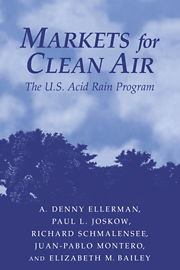Book contents
- Frontmatter
- Contents
- List of Illustrations
- List of Tables
- Preface
- Acknowledgments
- Part I Background
- Part II Compliance and Trading
- Part III Questions and Implications
- 10 Cost Savings from Emissions Trading
- 11 Errors, Imperfections, and Allowance Prices
- 12 Concluding Observations
- Appendix: Effect of Title IV on SO2 Emissions and Heat Input by Susanne M. Schennach
- Bibliography
- Index
10 - Cost Savings from Emissions Trading
Published online by Cambridge University Press: 10 December 2009
- Frontmatter
- Contents
- List of Illustrations
- List of Tables
- Preface
- Acknowledgments
- Part I Background
- Part II Compliance and Trading
- Part III Questions and Implications
- 10 Cost Savings from Emissions Trading
- 11 Errors, Imperfections, and Allowance Prices
- 12 Concluding Observations
- Appendix: Effect of Title IV on SO2 Emissions and Heat Input by Susanne M. Schennach
- Bibliography
- Index
Summary
COST SAVINGS IS THE GOAL
Emissions trading is advocated as a means for achieving environmental goals because the flexibility it provides to affected sources promises lower costs than do the usual source-specific mandates, standards, and other forms of prescription broadly characterized as “command-and-control” (CAC). With the choices made possible by a market-based emissions control policy, the costs of achieving any given level of environmental protection can be reduced below those incurred by CAC regulation. Alternatively, more environmental protection can be obtained for the same cost.
The magnitude of the cost savings potentially available through use of emissions trading has been the subject of study for a number of years, but the results have varied widely. Estimated ratios of the cost of an observed CAC program to that of a least-cost market-based alternative have ranged from just over 1 to over 20. The implication is that emissions trading could lead to negligible or enormous savings, depending on the costs of the CAC program to which the efficient, market-based alternative is compared. These earlier studies were performed with the considerable handicap of being able only to compare the unappealing, observed reality of CAC programs with simulated and often idealized market-based alternatives. This defect was unavoidable because so few market-based alternatives have been available to observe, and, with one or two exceptions, these few have not been notably successful. Now Title IV provides the opportunity to compare a real, market-based alternative, with all of its inevitable imperfections, with some hypothetical CAC alternative.
- Type
- Chapter
- Information
- Markets for Clean AirThe U.S. Acid Rain Program, pp. 253 - 296Publisher: Cambridge University PressPrint publication year: 2000



